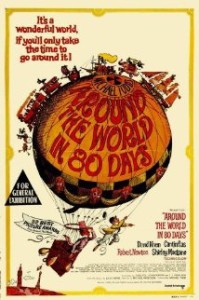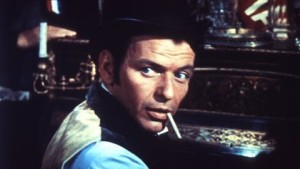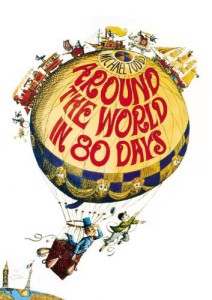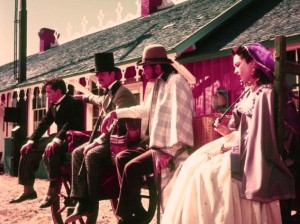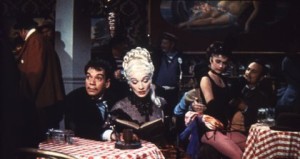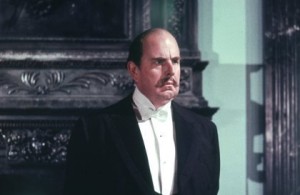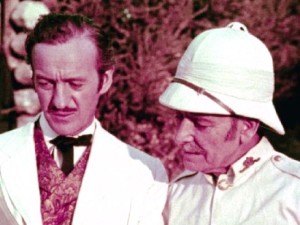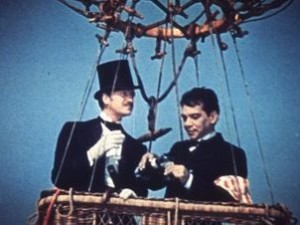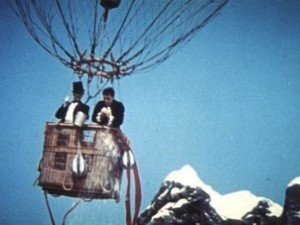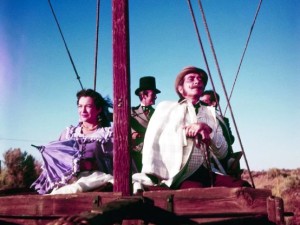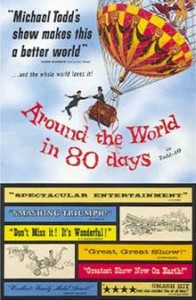Around the World in 80 Days **** (1956, David Niven, Cantinflas, Shirley MacLaine, Robert Newton, Finlay Currie, Robert Morley) – Classic Movie Review 2452
Director Michael Anderson’s 1956 Technicolor epic action adventure comedy film triumphed on Academy Award night, winning five rather undeserved Oscars, including Best Picture, Best Score, Best Adapted Screenplay, Best Cinematography and Best Film Editing.
Producer-showman Michael Todd, a Broadway impresario who had never before produced a movie, assembles 50 guest stars in a publicity-conscious move that helps to fill the 177-minute movie’s huge wide-open spaces. There’s plenty of time to spot and count them, and that’s amusing time-passer.
Ideal choice David Niven is good fun as Jules Verne’s English Victorian adventurer Phileas Fogg who takes a highly publicised £20,000 wager from his fellow members at the London Reform Club that he can traverse the globe in 80 days. This is arrogant and rash, as losing the bet would ruin him financially. Cantinflas is fun too, if to a lesser extent, as his new, devoted valet, recent Latin immigrant Passepartout, who possesses some useful unusual skills.
The other main stars are Shirley MacLaine as Princess Aouda and Robert Newton as Inspector Fix, with Finlay Currie as Reform Club member Andrew Stuart and Robert Morley as Bank of England Governor Gauthier Ralph, another Reform Club member.
But James Poe, John Farrow and S J Perelman’s screenplay is low on wit, and is often slack and flabby, while Anderson’s direction needs more incisiveness and dynamism. Basically, this is a nice small-time movie masquerading as classic blockbuster vintage entertainment. But, nevertheless, it is still entertaining in its lumbering, old-fashioned sort of way.
The score is composed by Victor Young, and the Todd-AO 70 mm cinematography is by Lionel Lindon. The film’s seven-minute-long animated title sequence, shown at the end of the film, is created by award-winning designer Saul Bass.
Also in the cast are Charles Boyer, Joe E Brown, Martine Carol, John Carradine, Charles Coburn, Ronald Colman, Melville Cooper, Noel Coward, Ava Gardner, Reginald Denny, Andy Devine, Marlene Dietrich, Luis Dominguin, John Gielgud, Hermione Gingold, Jose Greco, Cedric Hardwicke, Trevor Howard, Glynis Johns, Buster Keaton, Evelyn Keyes, Beatrice Lillie, Peter Lorre, Edmund Lowe, A E Matthews, Mike Mazurki, Tim McCoy, Victor McLaglen, John Mills, Alan Mowbray. Ed Murrow, Jack Oakie, George Raft, Gilbert Roland, Cesar Romero, Frank Sinatra, Red Skelton, Ronald Squire, Basil Sydney and Harcourt Williams.
John Farrow and Kevin McClory also worked uncredited on the direction.
Many of the balloon scenes with Niven and Cantinflas were filmed with a 160-foot crane, but even that bothered the height-phobic Niven.
Alas, Newton did not live to see the film released. Niven alleged that Newton, who suffered with drink problems, was offered the part on condition that he did not drink any alcohol during the filming, and that his celebration after the completion of his role led to his death.
The movie cost $6million but by the time of Todd’s death in a plane crash 18 months later, it had grossed $33 million and eventually took $42million. The crew went to work in every country seen in the film, including England, France, India, Spain, Thailand and Japan.
The cast, including extras, totalled 68,894 people and featured 7,959 animals, including four ostriches, six skunks, 15 elephants, 17 fighting bulls, 512 rhesus monkeys, 800 horses, 950 burros, 2,448 American buffalo, 3,800 Rocky Mountain sheep and a sacred cow that eats flowers on cue, plus a cat at the Reform Club. The wardrobe department spent $410,000 to provide 74,685 costumes and 36,092 trinkets. Filming the bullfight in Spain required 10,000 extras, with Cantinflas, a one-time bullfighter, as the matador.
© Derek Winnert 2015 Classic Movie Review 2452
Check out more reviews on http://derekwinnert.com

